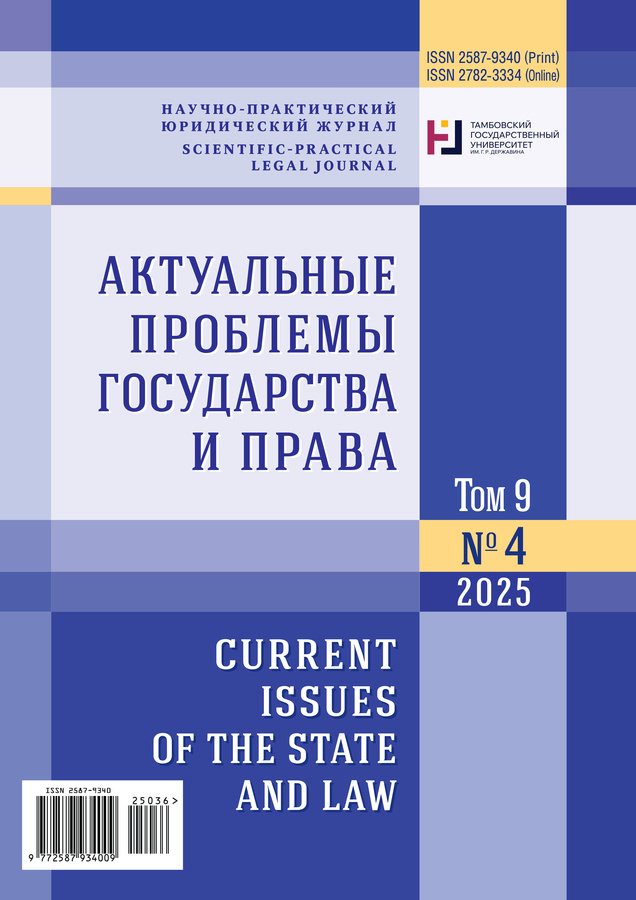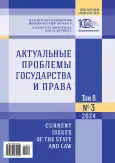Выборы народных судей в конце 1940-х – начале 1950-х годов: организация, проведение, итоги (на примере Курской области)
- Авторы: ИЛЬИНА Т.Н.1, БОГДАНОВА Н.А.1
-
Учреждения:
- ФГБОУ ВО «Курский государственный университет»
- Выпуск: Том 8, № 3 (2024)
- Страницы: 357-365
- Раздел: Общая теория и история права и государства
- URL: https://journal-vniispk.ru/2587-9340/article/view/303238
- ID: 303238
Цитировать
Полный текст
Аннотация
Рассмотрены основные вопросы, связанные с организацией и порядком проведения выборов народных судей в период с конца 1940-х до начала 1950-х гг. Проведен анализ принимаемых органами советской власти нормативных правовых актов, положения которых посвящены требованиям, предъявляемым к кандидатам на должности народных судей, принципам и порядку проведения выборов народных судей в конце 1940-х – начале 1950-х гг., сделан вывод о степени влияния политической партии на механизм формирования судейского корпуса. Данное влияние происходило в нескольких формах: от организации процедуры выборов, проведения избирательных кампаний до непосредственного участия в отборе и согласовании кандидатов на должности народных судей. Исследование архивных документов позволило сформировать реальное представление о процедуре выбора судей исследуемого периода времени. Многие из документов, хранящихся в архивах Курской области, впервые вводятся в научный оборот. Полагаем, что Курская область в данном случае представляла собой типичный пример процедуры формирования судейского корпуса в РСФСР. Системный анализ нормативных актов, архивных документов и юридической литературы позволил сделать вывод о том, что, несмотря на полную нормативную регламентацию порядка организации и проведения выборов народных судей, механизм формирования судейского корпуса был несовершенен и нуждался в реформировании.
Ключевые слова
Об авторах
Татьяна Николаевна ИЛЬИНА
ФГБОУ ВО «Курский государственный университет»
Автор, ответственный за переписку.
Email: tanayunik@rambler.ru
ORCID iD: 0000-0001-9880-2359
кандидат юридических наук, доцент, декан юридического факультета
Россия, Российская Федерация, 305000, г. Курск, ул. Радищева, 33Наталия Андреевна БОГДАНОВА
ФГБОУ ВО «Курский государственный университет»
Email: n.a.bogdanova96@mail.ru
ORCID iD: 0009-0002-3200-8990
аспирант, юридический факультет
Россия, Российская Федерация, 305000, г. Курск, ул. Радищева, 33Список литературы
- Вражнов А.С. К вопросу об избрании мировых судей // Мировой судья. 2017. № 9. С. 16-19. https://elibrary.ru/zeneqh
- Клеандров М.И. О суде уровня звенности ниже мировой юстиции // Мировой судья. 2018. № 5. С. 10-21. https://elibrary.ru/yxjrwo
- Колоколов Н.А. Мировая юстиция – важная форма стабилизации человеческих отношений в гражданском обществе // Мировой судья. 2003. № 1. С. 2-11. https://elibrary.ru/ogjhmb
- Севрюков Д.С. Организационно-правовой механизм наделения полномочиями народных судей в РСФСР во второй половине 40-х – начале 50-х гг. XХ в. // Право и политика. 2014. № 1. С. 80-85. https://elibrary.ru/ruelwf
- Егоров С.Г., Трушков С.А., Цеглеев Э.А. Выборы народных судей и народных заседателей в Кировской области в 1948 г. // Вопросы истории. 2021. № 8-1. С. 244-250. https://doi.org/10.31166/VoprosyIstorii202108Statyi20, https://elibrary.ru/bgbhlw
- Ильина Т.Н. Номенклатурный принцип формирования судейского корпуса в РСФСР: понятие, содержание, итоги // Образование и право. 2021. № 9. С. 266-274. https://doi.org/10.24412/2076-1503-2021-9-266-274, https://elibrary.ru/wcbtrt
- Васильев Д.С. Народный суд в послевоенное десятилетие: структура, организация, кадры, повседневность (на материалах Ленинского района г. Новосибирска // Серовские чтения: сб. науч. тр. Всерос. науч. конф., посвящ. памяти выдающегося ученого Дмитрия Олеговича Серова (1963–2019 гг.) / отв. ред. Д.А. Савченко, М.С. Саламатова, Д.С. Васильев. Новосибирск: НГУЭУ, 2021. С. 54-99. https://elibrary.ru/oodkxf
- Кодинцев А.Я. Кадровый состав советский судов в послевоенные годы // Администратор суда. 2011. № 3. С. 36-40. https://elibrary.ru/oipgor
- Кодинцев А.Я. Государственная политика в СССР в 30–50-е годы ХХ века в сфере юстиции. Куртамыш: Куртамышская типография, 2008. 600 с. https://elibrary.ru/sdelfx
- Пашкевич П.Ф. Демократические принципы советского правосудия. Методический материал в помощь лектору в связи с выборами народных судей г. Москвы. М., 1975. 47 с.
- Ильина Т.Н. Основные направления реформирования механизма формирования судейского корпуса в России в конце 1980 – начале 1990-х годов // Историко-правовые проблемы: Новый ракурс. 2019. № 4. С. 176-182. https://elibrary.ru/jxgjgy
- Труфанов С.В. Кадровая политика в отношении судейского корпуса в Курской области в 50–70 годы XX века // Наука и современность. 2011. № 13-1. С. 136-141. https://elibrary.ru/rnedyd
Дополнительные файлы










